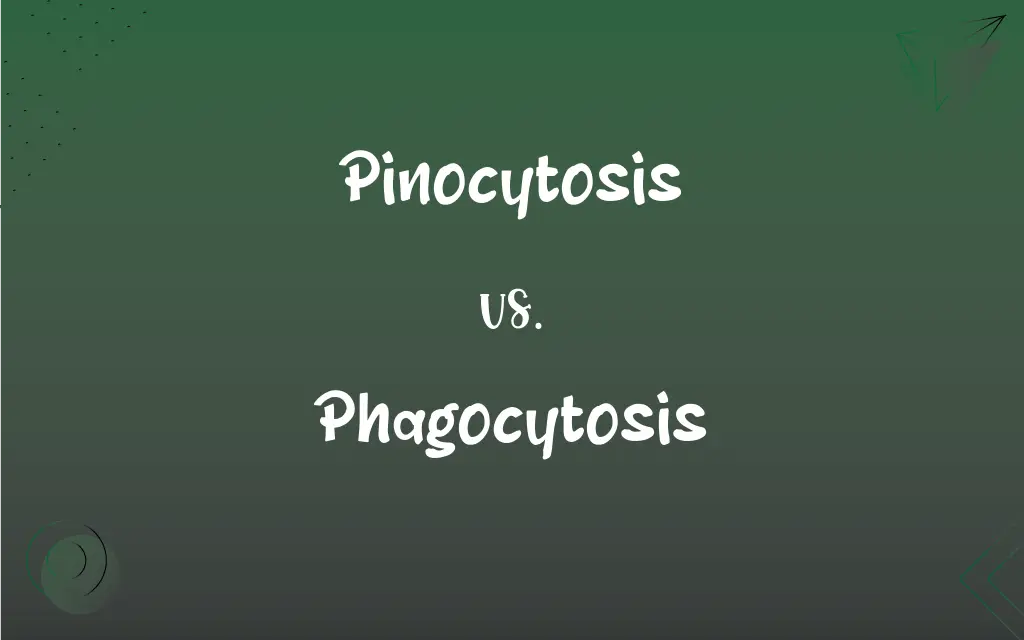Pinocytosis vs. Phagocytosis: What's the Difference?
Edited by Janet White || By Harlon Moss || Updated on October 28, 2023
Pinocytosis is the cellular process of engulfing liquid particles, while phagocytosis involves the ingestion of large solid particles or cells.

Key Differences
Pinocytosis is a subtype of endocytosis where a cell engulfs small amounts of extracellular fluid. This is often described as "cell drinking". Phagocytosis, on the other hand, is the cellular process where larger particles, such as bacteria or dead cells, are ingested.
In pinocytosis, small vesicles form to capture and transport liquid particles inside the cell. This process doesn't usually discriminate between the types of molecules it engulfs. Conversely, phagocytosis is more targeted, where cells actively seek out and ingest specific large particles or pathogens.
While pinocytosis is more of a routine and continuous process, phagocytosis is often a defense mechanism. Immune cells, like macrophages, use phagocytosis to ingest and destroy pathogens.
The vesicles formed during pinocytosis are smaller compared to those formed during phagocytosis. In phagocytosis, the engulfed particle is stored in a phagosome, which eventually merges with a lysosome to digest the ingested material.
Both pinocytosis and phagocytosis are vital for maintaining cellular homeostasis. They help in nutrient acquisition, waste removal, and protection against harmful entities.
ADVERTISEMENT
Comparison Chart
Type of Particles Engulfed
Liquids and solutes.
Larger particles, like bacteria or dead cells.
Function
"Cell drinking"; routine uptake of extracellular fluid.
Active defense; ingestion and destruction of harmful entities.
Vesicle Size
Small vesicles.
Larger vesicles, known as phagosomes.
Selectivity
Non-specific.
Targeted towards specific particles or pathogens.
Major Cells Involved
Most cells.
Specialized cells, mainly macrophages and neutrophils.
ADVERTISEMENT
Pinocytosis and Phagocytosis Definitions
Pinocytosis
Pinocytosis is often referred to as "cell drinking".
In pinocytosis, the cell's membrane invaginates to engulf extracellular fluid.
Phagocytosis
Phagocytosis is the cellular ingestion of large particles or cells.
Macrophages use phagocytosis to remove dead or dying cells.
Pinocytosis
Pinocytosis is the cellular uptake of fluids and solutes.
During nutrient absorption, intestinal cells often utilize pinocytosis.
Phagocytosis
Phagocytosis is executed by specialized cells in the immune system.
Neutrophils employ phagocytosis to capture and neutralize invading bacteria.
Pinocytosis
Pinocytosis involves small vesicles forming inside cells.
Through pinocytosis, cells can continually sample the extracellular environment.
Phagocytosis
Phagocytosis is a crucial defense mechanism against pathogens.
White blood cells engulf bacteria through phagocytosis to protect the body.
Pinocytosis
Pinocytosis aids cells in acquiring nutrients from their surroundings.
The constant pinocytotic activity ensures that cells have access to essential solutes.
Phagocytosis
Phagocytosis involves the formation of large vesicles called phagosomes.
Once ingested, pathogens are trapped in phagosomes which later fuse with lysosomes.
Pinocytosis
Pinocytosis is a non-specific endocytic process.
Pinocytosis allows cells to take in molecules dissolved in extracellular fluid.
Phagocytosis
Phagocytosis plays a role in cleaning up cellular debris.
After tissue injury, phagocytosis helps remove dead or damaged cells.
Pinocytosis
Introduction of fluids into a cell by invagination of the cell membrane, followed by formation of vesicles within the cell.
Phagocytosis
The engulfing and destruction of particulate matter, such as a bacterium, by a cell.
Pinocytosis
(biology) A form of endocytosis in which material enters a cell through its membrane and is incorporated in vesicles for digestion.
Phagocytosis
A form of endocytosis in which a cell incorporates a particle by extending pseudopodia and drawing the particle into a vacuole of its cytoplasm.
Pinocytosis
Process by which certain cells can engulf and incorporate droplets of fluid
Phagocytosis
Process in which phagocytes engulf and digest microorganisms and cellular debris; an important defense against infection
FAQs
How does pinocytosis differ from phagocytosis?
Pinocytosis involves "cell drinking" of liquids, while phagocytosis engulfs larger solid particles.
What is pinocytosis?
Pinocytosis is a form of endocytosis where cells engulf extracellular fluid and its dissolved solutes.
Which cells primarily perform phagocytosis?
Macrophages and neutrophils are primary cells performing phagocytosis in the immune system.
Is pinocytosis selective?
Pinocytosis is generally non-specific, engulfing a portion of the surrounding fluid.
How are pathogens destroyed after phagocytosis?
Pathogens in phagosomes are fused with lysosomes, where they are broken down and neutralized.
Can pinocytosis be harmful to cells?
Generally, pinocytosis is beneficial, but excessive or unregulated activity could disrupt cellular functions.
Are phagocytosis and pinocytosis exclusive to animals?
No, some single-celled organisms also use these processes for feeding or defense.
Is pinocytosis energy-dependent?
Yes, pinocytosis requires energy, typically from ATP.
What is the role of vesicles in pinocytosis?
Vesicles form to internalize the engulfed fluid during pinocytosis.
Can phagocytosis lead to inflammation?
Yes, some byproducts of phagocytosis can trigger inflammatory responses.
How do cells ensure pathogens are destroyed post-phagocytosis?
Cells have lysosomes containing enzymes that fuse with phagosomes to digest the pathogens.
Can any cell perform phagocytosis?
While many cells can engulf particles, specialized cells like macrophages are more efficient at phagocytosis.
Is phagocytosis always beneficial?
While phagocytosis defends against pathogens, excessive or misdirected activity can harm tissues.
What triggers pinocytosis in cells?
Pinocytosis is often a continuous process, but certain stimuli can increase its rate.
Do all organisms use phagocytosis?
Phagocytosis is more common in multicellular organisms, especially those with an immune system.
How do cells recognize what to engulf in phagocytosis?
Cells recognize patterns on pathogens or rely on opsonization, where pathogens are marked for ingestion.
How does phagocytosis protect the body?
Phagocytosis is used by immune cells to capture and destroy harmful pathogens.
What happens to particles engulfed by pinocytosis?
Engulfed particles may be metabolized, utilized, or transported to other parts of the cell.
Do cells constantly undergo pinocytosis?
Most cells undergo pinocytosis routinely to monitor their environment and obtain nutrients.
Why is phagocytosis considered an immune response?
Because it's a primary mechanism for immune cells to capture and neutralize foreign invaders.
About Author
Written by
Harlon MossHarlon is a seasoned quality moderator and accomplished content writer for Difference Wiki. An alumnus of the prestigious University of California, he earned his degree in Computer Science. Leveraging his academic background, Harlon brings a meticulous and informed perspective to his work, ensuring content accuracy and excellence.
Edited by
Janet WhiteJanet White has been an esteemed writer and blogger for Difference Wiki. Holding a Master's degree in Science and Medical Journalism from the prestigious Boston University, she has consistently demonstrated her expertise and passion for her field. When she's not immersed in her work, Janet relishes her time exercising, delving into a good book, and cherishing moments with friends and family.































































